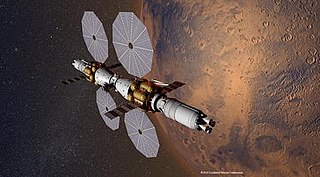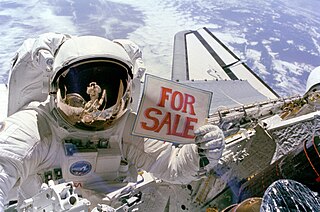
The Apollo program, also known as Project Apollo, was the United States human spaceflight program carried out by the National Aeronautics and Space Administration (NASA), which succeeded in preparing and landing the first humans on the Moon from 1968 to 1972. It was first conceived in 1960 during President Dwight D. Eisenhower's administration as a three-person spacecraft to follow the one-person Project Mercury, which put the first Americans in space. Apollo was later dedicated to President John F. Kennedy's national goal for the 1960s of "landing a man on the Moon and returning him safely to the Earth" in an address to Congress on May 25, 1961. It was the third US human spaceflight program to fly, preceded by the two-person Project Gemini conceived in 1961 to extend spaceflight capability in support of Apollo.

Human spaceflight is spaceflight with a crew or passengers aboard a spacecraft, often with the spacecraft being operated directly by the onboard human crew. Spacecraft can also be remotely operated from ground stations on Earth, or autonomously, without any direct human involvement. People trained for spaceflight are called astronauts, cosmonauts (Russian), or taikonauts (Chinese); and non-professionals are referred to as spaceflight participants or spacefarers.

Space exploration is the use of astronomy and space technology to explore outer space. While the exploration of space is currently carried out mainly by astronomers with telescopes, its physical exploration is conducted both by uncrewed robotic space probes and human spaceflight. Space exploration, like its classical form astronomy, is one of the main sources for space science.

The Space Shuttle program was the fourth human spaceflight program carried out by the U.S. National Aeronautics and Space Administration (NASA), which accomplished routine transportation for Earth-to-orbit crew and cargo from 1981 to 2011. Its official name, Space Transportation System (STS), was taken from a 1969 plan for a system of reusable spacecraft of which it was the only item funded for development. It flew 135 missions and carried 355 astronauts from 16 countries, many on multiple trips.

The Apollo Lunar Module, originally designated the Lunar Excursion Module (LEM), was the lunar lander spacecraft that was flown between lunar orbit and the Moon's surface during the United States' Apollo program. It was the first crewed spacecraft to operate exclusively in the airless vacuum of space, and remains the only crewed vehicle to land anywhere beyond Earth.
Human spaceflight programs have been conducted, started, or planned by multiple countries and companies. The age of manned rocket flight was initiated by Fritz von Opel who piloted the world's first rocket-propelled flight on 30 September 1929. All space flights depend on rocket technology; von Opel was the co-designer and financier of the visionary project. Until the 21st century, human spaceflight programs were sponsored exclusively by governments, through either the military or civilian space agencies. With the launch of the privately funded SpaceShipOne in 2004, a new category of human spaceflight programs – commercial human spaceflight – arrived. By the end of 2022, three countries and one private company (SpaceX) had successfully launched humans to Earth orbit, and two private companies had launched humans on a suborbital trajectory.

The Constellation program was a crewed spaceflight program developed by NASA, the space agency of the United States, from 2005 to 2009. The major goals of the program were "completion of the International Space Station" and a "return to the Moon no later than 2020" with a crewed flight to the planet Mars as the ultimate goal. The program's logo reflected the three stages of the program: the Earth (ISS), the Moon, and finally Mars—while the Mars goal also found expression in the name given to the program's booster rockets: Ares. The technological aims of the program included the regaining of significant astronaut experience beyond low Earth orbit and the development of technologies necessary to enable sustained human presence on other planetary bodies.

Private spaceflight refers to spaceflight developments that are not conducted by a government agency, such as NASA or ESA.

Blue Origin, LLC is an American aerospace manufacturer, defense contractor and launch service provider headquartered in Kent, Washington, United States. The company makes rocket engines for United Launch Alliance (ULA) and other customers as well as manufactures rockets, spacecraft and heavy-lift launch vehicles. The company is the second provider of lunar lander services for NASA's Artemis program and was awarded a $3.4 billion contract. The company has three rocket engines in production including the BE-3U, BE-3PM and BE-4. The company is working on a fourth rocket engine called the BE-7 which is still under development and when completed may be used on planetary bodies other than Earth.

Lunar orbit rendezvous (LOR) is a process for landing humans on the Moon and returning them to Earth. It was utilized for the Apollo program missions in the 1960s and 1970s. In a LOR mission, a main spacecraft and a smaller lunar lander travel to lunar orbit. The lunar lander then independently descends to the surface of the Moon, while the main spacecraft remains in lunar orbit. After completion of the mission there, the lander returns to lunar orbit to rendezvous and re-dock with the main spacecraft, then is discarded after transfer of crew and payload. Only the main spacecraft returns to Earth.

A Moon landing or lunar landing is the arrival of a spacecraft on the surface of the Moon. This includes both crewed and robotic missions. The first human-made object to touch the Moon was the Soviet Union's Luna 2, on 13 September 1959.
American private space transportation company SpaceX has developed and produced several spacecraft named Dragon. The first family member, now referred to as Dragon 1, flew 23 cargo missions to the ISS between 2010 and 2020 before retiring. With this first version not designed for carrying astronauts, it was funded by NASA with $396 million awarded through the Commercial Orbital Transportation Services (COTS) program, with SpaceX being announced as a winner of the first round of funding on August 18, 2006.

The Crew Exploration Vehicle (CEV) was a component of the U.S. NASA Vision for Space Exploration plan. A competition was held to design a spacecraft that could carry humans to the destinations envisioned by the plan. The winning design was the Orion spacecraft.

The retirement of NASA's Space Shuttle fleet took place from March to July 2011. Discovery was the first of the three active Space Shuttles to be retired, completing its final mission on March 9, 2011; Endeavour did so on June 1. The final shuttle mission was completed with the landing of Atlantis on July 21, 2011, closing the 30-year Space Shuttle program.

Lunar tourism may be possible in the future if trips to the Moon are made available to a private audience. Some space tourism startup companies are planning to offer tourism on or around the Moon, and estimate this to be possible sometime between 2023 and 2043.

Artemis 3 is planned as the first crewed Moon landing mission of the Artemis program and the first crewed flight of the Starship HLS lander. Artemis 3 is planned to be the second crewed Artemis mission and the first American crewed lunar landing since Apollo 17 in December 1972. As of 2023, the mission is scheduled for December 2025.

Mars Base Camp (MBC) is a crewed Mars laboratory orbiter concept under study that was commissioned by NASA from Lockheed Martin in US. It would use both future and proven concepts as well as the Orion MPCV, also built by Lockheed Martin.

The following is a timeline of important events in the history of private spaceflight, including important technical as well as legislative and political advances. Though the industry has its origins in the early 1960s, soon after the beginning of the Space Age, private companies did not begin conducting launches into space until the 1980s, and it was not until the 21st century that multiple companies began privately developing and operating launch vehicles and spacecraft in earnest.

The Artemis program is a robotic and human Moon exploration program led by the United States' National Aeronautics and Space Administration (NASA) along with six major partner agencies— the European Space Agency (ESA), the German Aerospace Center (DLR), the Japan Aerospace Exploration Agency (JAXA), the Canadian Space Agency (CSA), the Israel Space Agency (ISA), and the Italian Space Agency (ASI). The Artemis program is intended to reestablish a human presence on the Moon for the first time since the Apollo 17 mission in 1972. The main parts of the program are the Space Launch System (SLS), the Orion spacecraft, the Lunar Gateway space station, and the commercial Human Landing Systems. The program's long-term goal is to establish a permanent base on the Moon to facilitate the feasibility of human missions to Mars.


















